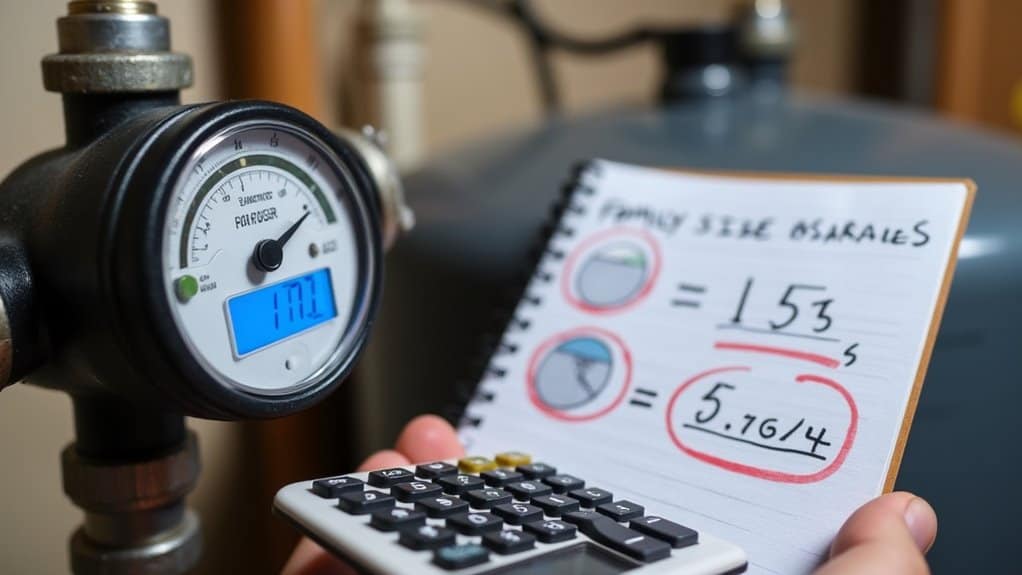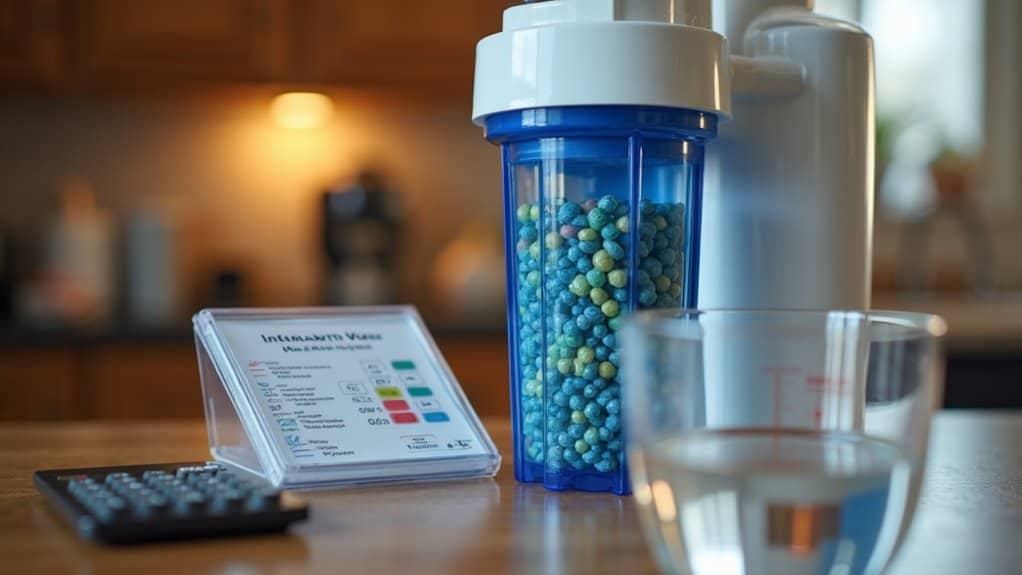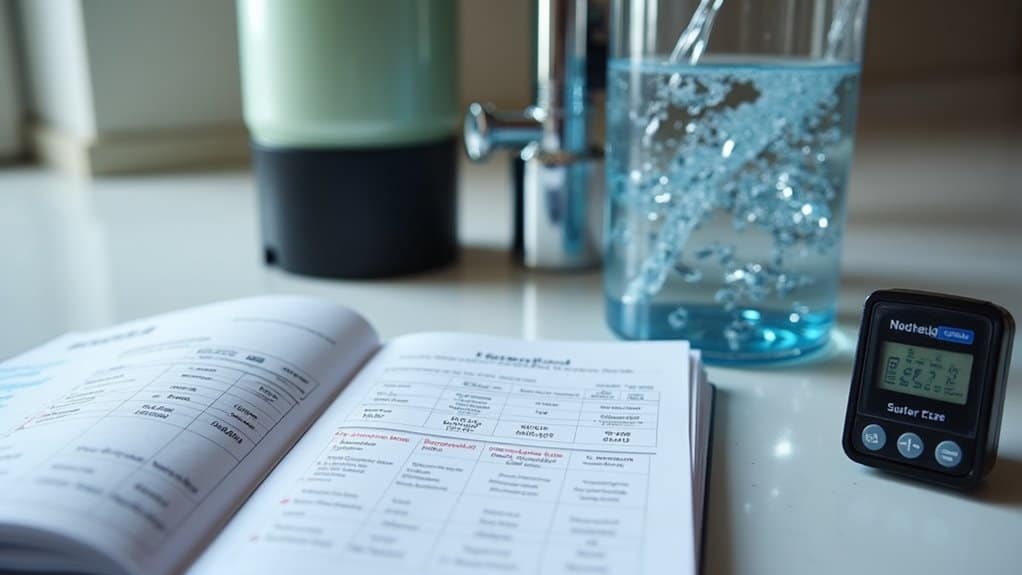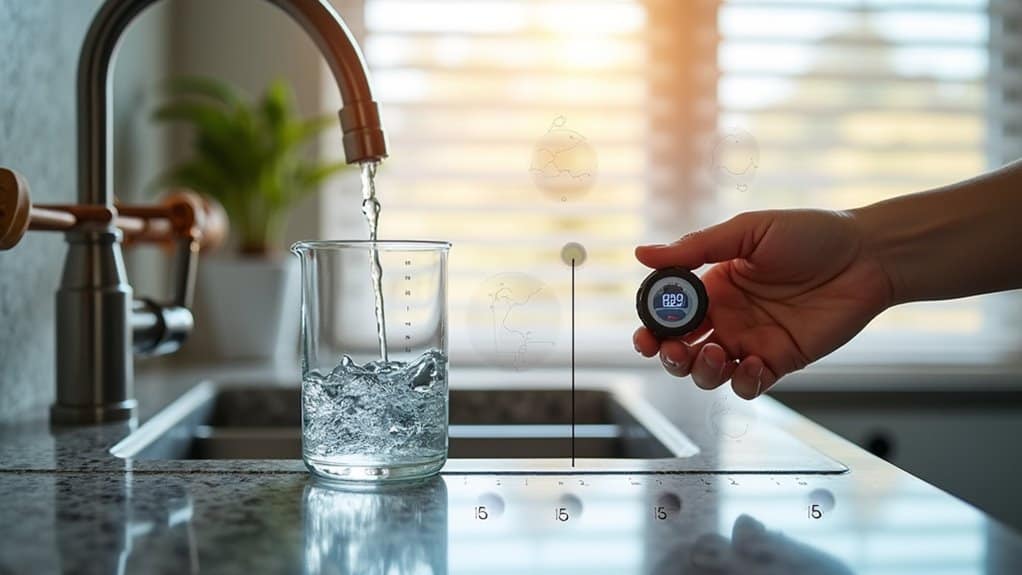Sizing a water softener correctly requires three key calculations: your water hardness (in GPG), daily water consumption (gallons per person), and total grain capacity needed. We multiply hardness by daily usage to determine grains removed daily, then add 25% reserve capacity for demand fluctuations. For iron contamination, add 5 grains per 1 ppm of iron. Manufacturer charts help, but our formula ensures precise sizing beyond their generalized recommendations. The right calculations prevent costly oversizing or insufficient treatment.
Key Takeaways
- Calculate daily grain load by multiplying water hardness (grains per gallon) by total daily household water usage.
- Add 5 grains per 1 ppm of iron content to your total hardness calculation for accurate sizing.
- Include a 25% reserve capacity buffer to accommodate usage spikes and ensure consistent performance.
- Actual water softener performance is typically 30-40% below manufacturer ratings in real-world conditions.
- Divide total weekly grain requirement by regeneration frequency to determine the minimum grain capacity needed.
Decoding Water Hardness: Your First Calculation Variable

When sizing a water softener correctly, understanding your water’s hardness level serves as the foundational calculation variable.
We measure hardness in several units, with grains per gallon (gpg), parts per million (ppm), or milligrams per liter (mg/L) being most common in residential applications. Understanding these measurement units is crucial for accurate conversions.
To convert between units, remember that 1 ppm equals 17.1 gpg, or 60 mg/L equals 3.5 gpg.
Water hardness primarily comes from calcium and magnesium ions, which we categorize as either temporary (carbonate) or permanent hardness.
For precise sizing, we’ll need to know your total hardness value, typically classified as soft (<60 mg/L) or hard (>200 mg/L). In French-speaking regions, water hardness is commonly measured using French degrees (°f) for standardized classification and treatment recommendations.
Mapping Your Household’s Real Water Consumption
After establishing your water hardness level, the next critical calculation factor is determining your household’s actual water consumption patterns.
While the standard estimate is 3,000 gallons per person monthly, real usage often exceeds this baseline. Household size plays a significant role in determining the overall capacity requirements for your water softener.
An average household consumes approximately 138 gallons daily (4,140 monthly), with toilets accounting for 31% of indoor use.
The average person unknowingly wastes 30 gallons of water daily through inefficient appliances and leaky fixtures.
Consider that outdoor activities drastically influence consumption—garden watering alone can add 18,000 gallons monthly at 5-10 GPM.
We must account for peak flow periods when multiple water-using appliances operate simultaneously, as these moments stress your system’s capacity most significantly.
The Essential Grain Capacity Formula Every Homeowner Needs

The proper sizing of a water softener depends fundamentally on calculating its required grain capacity—the measurement determining how many hardness minerals a system can remove before regeneration.
The core formula is straightforward: Grains/day = Hardness (GPG) × Daily Water Use.
For a typical four-person household using 300 gallons daily with water hardness of 10 GPG, that’s 3,000 grains daily or 21,000 weekly. This calculation is crucial because it ensures optimal efficiency in managing hardness minerals effectively.
Always include a 25% reserve capacity for peak demand and adjust for iron contamination (add 5 grains per 1 ppm of iron). Many homeowners should recognize that actual real-world performance often falls below the manufacturer’s stated capacity by approximately 30-40% due to testing conditions that may not reflect typical household usage patterns.
Sizing Charts: Translating Math Into the Perfect System Model

Now that you understand the grain capacity formula, let’s examine how to apply these calculations using standardized sizing charts.
Most manufacturers provide simplified selection tables based on household size and water hardness, but these require important adjustments:
- Iron compensation – Add 3-5 GPG per 1 ppm of iron present
- Buffer capacity – Ensure system operates at 80% utilization to accommodate usage spikes
- Peak flow rates – Select models with 25% margin above your household’s maximum demand
While GE, Lowe’s and Aquasana charts offer convenient starting points, always prioritize precise resin volume calculations over generalized recommendations for optimal efficiency and performance. Additionally, sizing charts often overlook specific variables that can significantly impact water quality. For GE models specifically, you can check parts availability by entering your ZIP code to ensure local servicing options before purchase.
Frequently Asked Questions
How Long Do Water Softener Resin Beads Typically Last?
We find that water softener resin beads typically last 10-15 years under ideal conditions, though they may reach 20 years with premium 10% cross-link resin and proper maintenance. Chlorine exposure significantly reduces longevity.
Can I Install a Water Softener Myself to Save Money?
We’d only recommend DIY installation if you possess basic plumbing skills. While you’ll save on labor costs, you’ll risk warranty invalidation, potential leaks, and improper setup if installed incorrectly.
Do I Need to Treat All Household Water or Just Hot Water?
We recommend treating both hot and cold water for comprehensive protection. Hot-only treatment reduces salt usage 30-50%, but leaves appliances like ice makers unprotected. Consider your hardness level and specific appliance warranty requirements.
How Does Water Pressure Change After Installing a Softener?
We’ll typically see a 3-5 psi pressure drop after softener installation due to flow restriction. Properly sized units minimize this impact, while undersized systems create significant pressure loss during peak demand periods.
Will a Water Softener Remove Harmful Bacteria or Viruses?
No, water softeners don’t remove bacteria or viruses. We’ve designed them solely for ion exchange to reduce calcium and magnesium. You’ll need dedicated filtration systems for pathogen removal.
Conclusion
We’ve demonstrated that proper water softener sizing requires precision mathematics rather than guesswork. By calculating your specific water hardness levels, quantifying your household’s actual consumption patterns, and applying our grain capacity formula, you’ll determine the optimal system requirements. These mathematical principles, when applied to manufacturer sizing charts, ensure you’re selecting a softener that operates at peak efficiency—neither undersized nor unnecessarily oversized for your specific water treatment needs.

Craig “The Water Guy” Phillips is the founder of Quality Water Treatment (QWT) and creator of SoftPro Water Systems.
With over 30 years of experience, Craig has transformed the water treatment industry through his commitment to honest solutions, innovative technology, and customer education.
Known for rejecting high-pressure sales tactics in favor of a consultative approach, Craig leads a family-owned business that serves thousands of households nationwide.
Craig continues to drive innovation in water treatment while maintaining his mission of “transforming water for the betterment of humanity” through transparent pricing, comprehensive customer support, and genuine expertise.
When not developing new water treatment solutions, Craig creates educational content to help homeowners make informed decisions about their water quality.


